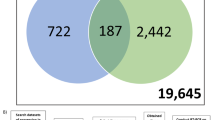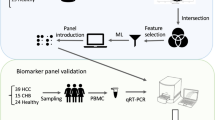Abstract
Background
Chemokines play a vital role in tumor progression, metastasis and prognosis; however, the profile and clinical significance of gamma interferon-inducible protein-10 (IP-10) and its receptor (CXCR3) in patients with hepatocellular carcinoma (HCC) have not been well evaluated.
Methods
Liquid-phase chip technology was used to detect the serum IP-10 in 85 patients with HBV-related HCC, 50 patients with chronic hepatitis B (CHB) and 50 liver cirrhosis subjects (CS); simultaneously, the CXCR3 and Alpha fetoprotein (AFP) were determined. Additionally, their mRNA or protein expression levels in peripheral blood mononuclear cells (PBMC), liver tumor and paracancerous tissues were quantified using qRT-PCR or ELISA. Moreover, the IP-10 and CXCR3 expression was verified by the online data from Gene Expression Omnibus. Furthermore, the relationships of serum IP-10, CXCR3 and AFP levels with their overall survival rate were also analyzed.
Results
The levels of IP-10 and CXCR3 in HCC group were significantly higher than those in CHB and CS groups, and their mRNA of PBMC is significantly positive correlation with those in their liver tissues or HBV DNA load (P < 0.0001), respectively. The serum IP-10 and CXCR3 in HCC were significantly correlated with tumor differentiation, metastases staging and distant metastasis (P < 0.05), but not related to gender, age and tumor size (P > 0.05, except IP-10 based on age).
Conclusions
The serum IP-10 (142.6 pg/mL) and CXCR3 (241.2 pg/mL) could be differential diagnostic surrogates that distinguish HCC from CS, and the lower IP-10 level may be conducive to the postoperative survival of HCC patients. Moreover, the IP-10 and CXCR3 would be related to anti-tumor immunity in HCC patients and be a potential target for treatment of HCC.





Similar content being viewed by others
Data availability statement
The datasets used and/or analyzed during the current study available from the corresponding author on reasonable request.
Abbreviations
- AFP:
-
Alpha fetoprotein
- CHB:
-
Chronic hepatitis B
- ELISA:
-
Enzyme-linked immunosorbent serologic assay
- GEO:
-
Gene expression omnibus
- HCC:
-
Hepatocellular carcinoma
- CS:
-
Cirrhosis subject
- IP-10 (CXCL10):
-
Gamma interferon-inducible protein-10
- CXCR3:
-
CXC subfamily receptor-3
- PBMC:
-
Peripheral blood mononuclear cells
- TNM:
-
Tumor, nodes, metastases
References
Britton C, Poznansky MC, Reeves P (2021) Polyfunctionality of the CXCR4/CXCL12 axis in health and disease: implications for therapeutic interventions in cancer and immune-mediated diseases. FASEB J 35:e21260
Chen VL, Sharma P (2020) Role of biomarkers and biopsy in hepatocellular carcinoma. Clin Liver Dis 24:577–590
Clark AM, Heusey HL, Griffith LG, Lauffenburger DA, Wells A (2021) IP-10 (CXCL10) can trigger emergence of dormant breast cancer cells in a metastatic liver microenvironment. Front Oncol 11:676135
Cong WM, Bu H, Chen J, Dong H, Zhu YY, Feng LH, Chen J (2016) Practice guidelines for the pathological diagnosis of primary liver cancer: 2015 update. World J Gastroenterol 22:9279–9287
Elia G, Fallahi P (2017) Hepatocellular carcinoma and CXCR3 chemokines: a narrative review. Clin Ter 168:e37–e41
Fasano R, Shadbad MA, Brunetti O, Argentiero A, Calabrese A, Nardulli P, Calbi R, Baradaran B, Silvestris N (2021) Immunotherapy for hepatocellular carcinoma: new prospects for the cancer therapy. Life (basel, Switzerland) 11:1355
Forner A, Reig M, Bruix J (2018) Hepatocellular carcinoma. Lancet 391:1301–1314
Groover MK, Richmond JM (2020) Potential therapeutic manipulations of the CXCR3 chemokine axis for the treatment of inflammatory fibrosing diseases. F1000Res 9:1197
Gufler S, Seeboeck R, Schatz C, Haybaeck J (2022) The translational bridge between inflammation and hepatocarcinogenesis. Cells 11:533
Guo R, Mao H, Hu X, Zheng N, Yan D, He J, Yang J (2016) Slow reduction of IP-10 Levels predicts HBeAg seroconversion in chronic hepatitis B patients with 5 years of entecavir treatment. Sci Rep 6:37015
Hueso L, Ortega R, Selles F, Wu-Xiong NY, Ortega J, Civera M, Ascaso JF, Sanz MJ, Real JT, Piqueras L (2018) Upregulation of angiostatic chemokines IP-10/CXCL10 and I-TAC/CXCL11 in human obesity and their implication for adipose tissue angiogenesis. Int J Obes 2005(42):1406–1417
Jia L, Gao Y, He Y, Hooper JD, Yang P (2020) HBV induced hepatocellular carcinoma and related potential immunotherapy. Pharmacol Res 159:104992
Lei Y, Xu X, Liu H, Chen L, Zhou H, Jiang J, Yang Y, Wu B (2021) HBx induces hepatocellular carcinogenesis through ARRB1-mediated autophagy to drive the G(1)/S cycle. Autophagy 17:4423–4441
Levrero M, Zucman-Rossi J (2016) Mechanisms of HBV-induced hepatocellular carcinoma. J Hepatol 64:S84-s101
Li CX, Ling CC, Shao Y, Xu A, Li XC, Ng KT, Liu XB, Ma YY, Qi X, Liu H, Liu J, Yeung OW, Yang XX, Liu QS, Lam YF, Zhai Y, Lo CM, Man K (2016) CXCL10/CXCR3 signaling mobilized-regulatory T cells promote liver tumor recurrence after transplantation. J Hepatol 65:944–952
Li L, Zhu YH, Li Y, Guan XY (2017) Identification of chemokine CXCL10 in tumor microenvironment by antibody array as a prognostic marker in hepatocellular carcinoma. Neoplasma 64:778–786
Li M, Chen L, Gao Y, Li M, Wang X, Qiang L, Wang X (2020) Recent advances targeting C-C chemokine receptor type 2 for liver diseases in monocyte/macrophage. Liver Int J 40:2928–2936
Ozga AJ, Chow MT, Lopes ME, Servis RL, Di Pilato M, Dehio P, Lian J, Mempel TR, Luster AD (2022) CXCL10 chemokine regulates heterogeneity of the CD8(+) T cell response and viral set point during chronic infection. Immunity 55:82-97.e88
Pan M, Wei X, Xiang X, Liu Y, Zhou Q, Yang W (2023) Targeting CXCL9/10/11-CXCR3 axis: an important component of tumor-promoting and antitumor immunity. Clin Transl Oncol 25:2306–2320
Petty AJ, Li A, Wang X, Dai R, Heyman B, Hsu D, Huang X, Yang Y (2019) Hedgehog signaling promotes tumor-associated macrophage polarization to suppress intratumoral CD8+ T cell recruitment. J Clin Invest 129:5151–5162
Ren T, Zhu L, Cheng M (2017) CXCL10 accelerates EMT and metastasis by MMP-2 in hepatocellular carcinoma. Am J Transl Res 9:2824–2837
Sagnelli E, Macera M, Russo A, Coppola N, Sagnelli C (2020) Epidemiological and etiological variations in hepatocellular carcinoma. Infection 48:7–17
Salarnia F, Behboudi E, Shahramian I, Moradi A (2021) Novel X gene point mutations in chronic hepatitis B and HBV related cirrhotic patients. Infect Genet Evol 97:105186
Sarin SK, Kumar M, Lau GK, Abbas Z, Chan HLY, Chen CJ, Chen DS, Chen HL, Chen PJ, Chien RN, Dokmeci AK, Gane E, Hou JL, Jafri W, Jia J, Kim JH, Lai CL, Lee HC, Lim SG, Liu CJ, Locarnini S, Al Mahtab M, Mohamed R, Omata M, Park J, Piratvisuth T, Sharma BC, Sollano J, Wang FS, Wei L, Yuen MF, Zheng SS, Kao JH (2016) Asian-Pacific clinical practice guidelines on the management of hepatitis B: a 2015 update. Hepatol Int 10:1–98
Sartorius K, Swadling L, An P, Makarova J, Winkler C, Chuturgoon A, Kramvis A (2020) The multiple roles of hepatitis B virus X protein (HBx) dysregulated MicroRNA in hepatitis B virus-associated hepatocellular carcinoma (HBV-HCC) and immune pathways. Viruses 12:746
Sekiba K, Otsuka M, Koike K (2021) Potential of HBx gene for hepatocarcinogenesis in noncirrhotic liver. Semin Liver Dis 41:142–149
Shang X, Wang L, Liu Y, Liu X, Lv J, Zhou X, Wang H, Nazierhan S, Wang J, Ma X (2021) Diagnostic value of CXCR3 and its ligands in spinal tuberculosis. Exp Ther Med 21:73
Tokunaga R, Zhang W, Naseem M, Puccini A, Berger MD, Soni S, McSkane M, Baba H, Lenz HJ (2018) CXCL9, CXCL10, CXCL11/CXCR3 axis for immune activation—a target for novel cancer therapy. Cancer Treat Rev 63:40–47
Tsai CF, Chen JH, Yeh WL (2019) Pulmonary fibroblasts-secreted CXCL10 polarizes alveolar macrophages under pro-inflammatory stimuli. Toxicol Appl Pharmacol 380:114698
Wang Q, Cheng ST, Chen J (2020) HBx mediated increase of SIRT1 contributes to HBV-related hepatocellular carcinoma tumorigenesis. Int J Med Sci 17:1783–1794
Wungu CDK, Ariyanto FC, Prabowo GI, Handajani R (2020) Association between five types of Tumor Necrosis Factor-α gene polymorphism and hepatocellular carcinoma risk: a meta-analysis. BMC Cancer 20:1134
Xie L, Yin J, Xia R, Zhuang G (2018) Cost-effectiveness of antiviral treatment after resection in hepatitis B virus-related hepatocellular carcinoma patients with compensated cirrhosis. Hepatology 68:1476–1486
Yan Y, Zheng L, Du Q, Yazdani H, Dong K, Guo Y, Geller DA (2021) Interferon regulatory factor 1(IRF-1) activates anti-tumor immunity via CXCL10/CXCR3 axis in hepatocellular carcinoma (HCC). Cancer Lett 506:95–106
Zhang Y, Zhao W, Li S, Lv M, Yang X, Li M, Zhang Z (2019) CXCL11 promotes self-renewal and tumorigenicity of α2δ1(+) liver tumor-initiating cells through CXCR3/ERK1/2 signaling. Cancer Lett 449:163–171
Zhou H, Wu J, Wang T, Zhang X, Liu D (2016) CXCL10/CXCR3 axis promotes the invasion of gastric cancer via PI3K/AKT pathway-dependent MMPs production. Biomed Pharmacother 82:479–488
Funding
This work was supported by the National Key Research and Development Program of China (2021YFC2301804), the Zhejiang Province Traditional Chinese Medicine Science and Technology Plan Project (2023ZL482), and the National Natural Science Foundation of China (Grant no. 82072357).
Author information
Authors and Affiliations
Contributions
JZ conceived and designed the study. YT and CF performed the experiment and writing the paper. XY and LL contributed to the experiment. XF performed data acquisition and analysis. All authors have carefully read and approved the submitting manuscript.
Corresponding authors
Ethics declarations
Conflict of interest
The authors declare no competing interests.
Institutional review board statement
All experiments were performed in accordance with relevant guidelines and regulation.
Additional information
Publisher's Note
Springer Nature remains neutral with regard to jurisdictional claims in published maps and institutional affiliations.
Supplementary Information
Below is the link to the electronic supplementary material.
Rights and permissions
Springer Nature or its licensor (e.g. a society or other partner) holds exclusive rights to this article under a publishing agreement with the author(s) or other rightsholder(s); author self-archiving of the accepted manuscript version of this article is solely governed by the terms of such publishing agreement and applicable law.
About this article
Cite this article
Li, Y., Wang, C., Yin, X. et al. Profile and clinical significance of interferon gamma-inducible protein-10 (IP-10) and its receptor in patients with hepatocellular carcinoma. J Cancer Res Clin Oncol 149, 14879–14888 (2023). https://doi.org/10.1007/s00432-023-05265-1
Received:
Accepted:
Published:
Issue Date:
DOI: https://doi.org/10.1007/s00432-023-05265-1




